Carrie Pratt Elwell - Could Look Back 90 Years In San Rafael Daughter Of A Pioneer Merchant Recalled Town Of Her Childhood - Daily Independent Journal - 16 Jan 1965, Sat - Pages 31 - 33
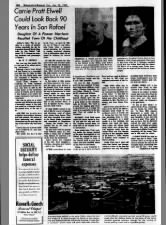 Carrie Pratt Elwell Could Look Back 90 Years in San Rafael (part
1)
Sat, Jan 16, 1965 – Page 31 ·
Daily Independent Journal (San Rafael, California) ·
Newspapers.com
Carrie Pratt Elwell Could Look Back 90 Years in San Rafael (part
1)
Sat, Jan 16, 1965 – Page 31 ·
Daily Independent Journal (San Rafael, California) ·
Newspapers.com
Carrie Pratt Elwell Could Look Back 90 Years In San Rafael
Daughter Of A Pioneer Merchant Recalled Town Of Her Childhood
(Editor's Note: This is another in a series of articles written especially for the Independent-Journal Marin Magazine by San Rafael "old-timer" W. T. Ortman on early-day incidents and personages of Marin.)
By W. T. ORTMAN
One year ago this month, Marin lost one of its oldest surviving “native
born.”
Although Carrie Pratt Elwell left San Rafael as a schoolgirl and died Jan. 31, 1964, in Oakland, she was Marin born, and she remained a Marinite at
heart throughout her life.
Carrie Pratt, daughter of Frederick H. Pratt, business man and postmaster of
San Rafael, was born in 1870 in the family home at the northwest corner of Fourth and B streets in San Rafael even before the young community had been
incorporated.
 |
| Marin Journal
, Volume 7, Number 38, 7 December 1867 |
 |
| Marin Journal
, Volume 8, Number 29, 3 October 1868 |
 |
| Marin Journal, Volume 17, Number 6, 19 April 1877 — Page 2 Advertisements Column 4 [ADVERTISEMENT] |
She was to serve as a court reporter and librarian and enjoy a successful
career in the business world as a financier before she passed away at the
age of 94.
AND SHE was to serve as a delightful intermediary between past and present,
the source of much interesting and valuable information on the early-day
history of her native city and county.
Carrie was one of seven children of Frederick H. and Josephine Pratt.
[I believe Josphine Pratt = Josefa Pimentel, AKA Josephine Ponce De Leone. Not sure how Pimentel relates to Ponce de Leon, but if you search them, they're part of a longer Spanish name, Pimentel y Ponce de León. - MF]
Her father was born in Saybrook, Conn., on April 18, 1824, the son of Titus C. and Elizabeth Pratt. After a common school education, he left home to wander westward, stopping first in Milwaukee where he engaged in business for several years.
IN 1843 HE crossed the Missouri River and traveled southwest into Mexico and
Honduras. Then in Nicaragua he stopped to engage in the mercantile business.
After several years there, his next venture was in Oregon where he set up a
small mercantile firm not far from Grants Pass.
In the winter of 1855, during an Indian massacre, the town and his
store-were burned to the ground. Fred Pratt escaped and came to California,
making his way to Spanishtown in Butte County where he once again went into
the mercantile business in the spring of 1856.
IT HAD BEEN settled in the fall of 1855 by a party of Spanish and Mexicans,
most of whom were miners from Sonora. They had been recruited from mines in
the Sierra Madre mountains and assembled at Magdalena.
Among the leaders was a Spanish don by the name of Juan Tiementen.
[I believe Juan Tiementen = Manuel Pimentel, believe it or not. Some of the biographies name Josephine Piementen, from which I guess Tiementen is derived. Bad notes? I think Pimentel -> Piementen -> Tiementen. Her obituary, and genealogy sites familysearch and ancestry say her maiden name was Josephine Ponce de Leon. This is her family tree on ancestry.com. - MF]
He had come with his parents from Valencia, Spain, as a boy. While a young
man in Magdalena, Mexico, he married a senorita [sic] from his motherland.
Juan's family now consisted of his wife, three daughters - Caroline,
Josephine and Ventura - and a son, Prosper.
[I think Caroline = Concepcion Pimentel, Josephine = Josefa Pimentel and Ventura = Ventura Pimentel and Prosper = Prospero Salazar. I think Prospero would have been a grandson of Juan / Manuel Pimentel, as he's the son of Concepcion and Domingo Salazar. There were other siblings, children of Manuel, however. See his linked record on ancestry.com, if you can login. Thanks to ancestry user zohagan for the tree. - MF]
AFTER establishing his store in Spanishtown, Fred Pratt met the Tiementen
family and fell in love with Josephine.
On June 27, 1856, Josephine and Fred were married. To them were born seven
children - Alexander, Frances Josephine, Oscar Collins, Edwin W., [Edward W.?] Frederick W., Carrie and William.
[Ancestry.com shows an eighth child, Julius Pratt. - MF]
When the gold deposits in Spanish Ravine gave out, the news arrived that
there had been a great strike on the Comstock Lode in Nevada. The word so
revived the lagging gold fever in Spanishtown as to empty the town of its
population to the last soul. They all rushed to the Comstock.
WEAKLY, Fred Pratt again loaded his stores aboard a wagon and with his wife
and their five children moved down the north fork of the Feather River to
Sacramento.
Some weeks later, Fred, walking beside his horses, plodded up the main
thoroughfare of San Rafael. He stopped his team at a watering trough in
front of the Central Hotel to give them water and then obtained rooms in the
hotel for his family.
[Maybe it was San Rafael Hotel? Central Hotel was in Petaluma. - MF]
Within a week Frederick H. Pratt set up a store on Fourth Street and was
again in business.
On Oct. 14, 1867, Pratt was appointed postmaster of San Rafael.
"THE POST office was located at Fourth and C at that time," stated his
daughter, Carrie, remembering the statements of her father. "It was still
the location where the original San Rafael post office had been established
in 1851. The first postmaster had been Moses Stoppard."
Carrie Pratt spent the first 10 years of her life in her father's two-story
brick house on the northeast corner of Fourth and B. During this time San
Rafael was emerging from a "cowtown” atmosphere to a small pueblo of a few
buildings and shacks that lined the dusty, deep-rutted old Olema Road along
which were driven Mexican longhorn cattle from the James Black and Tim
Murphy ranchos to the slaughter house of the Robert C. Clark, Moylan &
Scribner meat company at Sim's Landing.
Carrie Pratt was 4 years old when San Rafael was incorporated as a town. At
the time the population was only 800 people including many Mexicans, some
Indian woodchoppers and a few disillusioned Yankee gold miners from the
Sierra.
THERE WERE still a few Spanish dons living on their ranchos in the outlying
country.
Many of the settlers in Marin County had come down from the Sierra Nevada
when the gold deposits gave out. They never, however, really rid themselves
of the gold fever.
"It was in their blood,” recalled Carrie Pratt, remembering the stories her
father told her. "In May, 1863, someone discovered a small vein of quartz on
the John Reed ranch near Sausalito. It may have had a trace of gold. Then,
again, it may not have. But the discovery revived the gold fever again, and
sent it to heights previously unknown. The gold-maddened Americans in Marin
County went completely off the beam. There was a wild rush for claims.
"I DON'T KNOW but what my father was one of them," commented Carrie as we
sat on the terrace beneath the oaks at her beautiful home overlooking
Oakland and the bay. “For years...
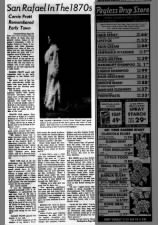 Carrie Pratt Elwell Could Look Back 90 Years in San Rafael (part
2)
Sat, Jan 16, 1965 – Page 32 ·
Daily Independent Journal (San Rafael, California) ·
Newspapers.com
Carrie Pratt Elwell Could Look Back 90 Years in San Rafael (part
2)
Sat, Jan 16, 1965 – Page 32 ·
Daily Independent Journal (San Rafael, California) ·
Newspapers.com
San Rafael In The 1870s
Carrie Pratt Remembered Early Town

|
|
THE YOUNG LIBRARIAN Carrie Pratt Elwell had good reason to be proud of the Paris gown she wore in this photo. She had won it as first prize in an essay contest conducted by a San Francisco newspaper. |
...there was a list of names among his effects of those who had secured
claims. Some of the names I remember - Rev. S. Looten, [Lootens?] Robert C. Clark, J.
Angellette and John Simmons. Nothing ever came of this, my father told me.
And although it was before my time, still I remember many of these men.”
The last time I visited Carrie Pratt Elwell at her sylvan retreat in the East Oakland hills was in 1963. She was much enfeebled. One of her hands was
useless as she had experienced a mild stroke.
CARRIE PRATT could still remember back to her early childhood in San Rafael
very well.
She spoke much of San Rafael, remembering vividly the quiet little town with
its dirt roads and the hitching posts along the curb.
The buildings along the two business streets were mostly two-story
structures with, in many cases, wooden porches extending out to the edge of
the sidewalk. The walks were at first of redwood planks, and restricted to
the business section. Out Fourth Street beyond D were only dirt paths on
either side of the road.
TRAVEL WAS sparse. Here and there a buggy or a surrey would go by. Once in a
while a farmer would come to town in a wagon drawn by a team of horses and
tie up in front of her father's store.
Her home, of course, was the focal point around which her young life
revolved in the 1870s.
“My father's home was a large, two-story house made of brick. It was, with
the exception of the Central Hotel, a three-story structure, then the
largest building in town," stated Carrie Pratt. "He built it to house both
his business and our home. Upstairs were large rooms, and all in French
decor with marble fireplaces throughout.
“BUT THE best of all our possessions was the block-size piece of land which
father owned. It included everything a ranch should have, in those days. It
contained a stable with horses; a buggy and a three-seated carriage with a
fringe on top, called a surrey; a flock of geese, chickens, and a vegetable
garden. Our cow furnished cream for our own butter." Here Carrie smiled.
"I was the milkmaid who carried buttermilk to Dr. A. W. Taliaferro, a
refreshment he was very fond of. He was a pioneer who came to San Rafael
with the Virginia mining company ... a country doctor who was at the peak of
his very useful career in those days. There was a shortage of dentists, so
Doctor Taliaferro pulled teeth along with caring for our other ills."
CARRIE PRATT paused only briefly in her talk.
“As a child I would sit at the window of my father's house, look across the
street to where now stands the Crocker-Citizens bank, and watch the Chinese
coolies plant onions for the San Francisco market," she said.
 Crocker-Citizens National bank Thu, May 13, 1965 – Page 34 · Daily Independent Journal (San Rafael, California) · Newspapers.com
Crocker-Citizens National bank Thu, May 13, 1965 – Page 34 · Daily Independent Journal (San Rafael, California) · Newspapers.com
Carrie Pratt dated the time of the onion farm as “before ‘Old Bill' Barnard
built his San Rafael livery stable at Fourth and B."
“I WAS STILL only a child when the courthouse was finished," she went on. "I
have only a child's memory of those things I liked about the courthouse. Not
withstanding the play possibilities I had on my father's ranch-like place,
my greatest delight was the lawn surrounding the courthouse. There I played
house under the trees and interviewed the prisoners in the jail as they
looked out through the tight bars.
"Talking to a little girl was great fun for them, too.
“The sprawling courthouse lawn was full of mushrooms. I ate some and took
some home to mother. She was horrified, insisting they were toadstools and
poisonous. Consequently, she gave me some medicine I never forgot.”
DURING MY visits to Carrie Pratt's home in East Oakland, I learned much of
her background.
Carrie Pratt's aunt, Caroline Tiementen, an older sister of her mother,
Josephine, was married to a mine owner named Salajor. Her daughter, Caroline
Salajor, was Mrs. Gordon Frank Glidden and lived at Second and B streets.
She was godmother to Carrie and named her Caroline Josephine Pratt.
[I believe Caroline Tiementen = Concepcion Pimentel, the "mine owner named Salajor" is Domingo Salazar, Caroline Salajor = Carolina Salazar, who did marry Gordon Francis Glidden and I guess Carrie = Caroline Josephine Pratt = Carrie Pratt. I think Mrs. Ida Glidden Toriati = Ida E Glidden, who married George Toriati. She would be Carrie's first cousin, once removed, daughter of Caroline / Carolina, granddaughter of Concepcion.- MF]
These people have all passed from the scene. The only surviving descendent
of this goldseeking group of 49ers now alive that I know of is Mrs. Ida
Glidden Toriati. She lives in San Juan Bautista.
IDA GREW up in San Rafael and was graduated from the St. Raphael School. She
came to San Rafael with her parents in 1901, and was well known in town.
Old-timers will remember her as the “candy girl" at the Columbus Candy
store. Later, she became telephone supervisor at the local exchange.
I asked Carrie if she had known William T. Coleman who lived in San Rafael
during her youth.
"Oh yes," replied Carrie with delight at being reminded of that gentleman.
"Mr. Coleman's son, Bobbie, and I went to the same private school. He would
walk home with me en route to his own home, only a few blocks away.
"ALSO IN the 1870s,” Carrie continued, "the great war had not been over very
long and on Decoration Day people in great numbers would go to the cemetery
and decorate the soldiers' graves." During my last visit to Carrie...
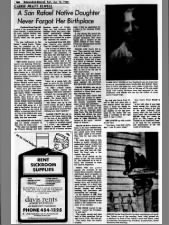 Carrie Pratt Elwell Could Look Back 90 Years in San Rafael (part
3)
Sat, Jan 16, 1965 – Page 33 ·
Daily Independent Journal (San Rafael, California) ·
Newspapers.com
Carrie Pratt Elwell Could Look Back 90 Years in San Rafael (part
3)
Sat, Jan 16, 1965 – Page 33 ·
Daily Independent Journal (San Rafael, California) ·
Newspapers.com
CARRIE PRATT ELWELL
A San Rafael Native Daughter Never Forgot Her Birthplace
...I asked if she remembered Dr. Galen Burdell. I asked because his sister, Adeline Burdell, was my grandmother, and I was curious about the old gentleman.
"He was well-known in San Rafael," stated Carrie. "Somehow, he reminded me
of a southern plantation owner. He lived at the Olompali Rancho near Novato.
There the doctor maintained a beautiful Roman-style villa with veranda on his
30,000-acre estate.
"THE BASIC business of the rancho was dairying. However, Doctor Burdell gave
more attention to a small vineyard near the villa. He much preferred being
known as a viticulturist. This, perhaps, was due to his ancestors being
vineyardists in Bordeaux, France.
"During the holiday season Doctor Burdell would send big turkeys and ranch
produce to his many friends in San Rafael.
“There were also other families in the vicinity of the Olompali Ranch whom I
remember. One was the Robert C. Clark family. They lived on the old Ramon Mesa Rancho west of Novato. Robert Clark had bought this property, which
consisted of about 4,000 acres, at a tax sale in San Rafael. He was
accidentally killed on his ranch in 1872 by a runaway team of horses. Two of
his children who were with him in the wagon were badly hurt but recovered.
“HIS WIDOWED wife Isabella, and her family continued to live there for many
years.
"The other two families were the Francis DeLong and John Sweetzer [Sweetser] people at Novato. They, too, had immense land holdings where they
grew vegetables, particularly cabbage, and much fruit. The Sweetzer apples
were crushed for a cider that captured the market.”
In mentioning these four families, Carrie's eyes sparkled. Then her thoughts
moved on.
“Out in front of father's store was a wooden post set in the sidewalk," she
continued. "It was about five feet high and on the top it had a small,
footsquare platform. On the top of this post, father had a live monkey. We
called him Joco. He created much fun for the children as they passed the
store."
WHEN FRED Pratt sold the store and left San Rafael, he moved his family to
Alameda. Carrie was sent to boarding school.
Later, as a young lady, she went to work for the Alameda Statesman as a
stenographer.
“In 1892," related Carrie, “James Barber started the newspaper with three
employees - himself, his stenographer and a printer. I was paid $15 a month.
We lasted about two years, then closed the doors.
"My father was up in Del Norte County. He had a timber claim on Mill Creek.
I went up there and lived in Crescent City, working as a court reporter."
CARRIE PRATT did not remain in Del Norte County long. At the turn of the
century she came back to the Bay Area.
"I wanted to establish myself as a writer,” she explained. "I wanted a
position that would place me in a literary environment. I filed an application for a place in the Alameda Public Library.”
It was during this period she met Frank D. Elwell, scion of a socially
prominent Bay Area family and a relative of the Albert Dibbles [Dibblee] of Ross
Valley. Frank had distinguished himself as a civil engineer.
[I think Frank's aunt Anna Roxalina Meachum was married to Albert T Dibblee. - MF]
FRANK AND Carrie fell in love. They married and honeymooned, in Yosemite
Valley.
Upon their return to the Bay Area, they took up residence in Alameda. Frank
had a business office in Oakland. During the year following their marriage
Frank obtained a piece of land in the East Oakland foothills. It was to be
the site of their future home.
Frank had only the foundation laid when he was called to the Orient. The new
Chinese republic was in the process of tying together the provinces with
up-to-date communications.
FRANK ELWELL was put in charge of a railroad project. He remained in China
three years, then returned home.
During this time Carrie had accepted the position of assistant librarian in
Alameda. Here she became acquainted with many writers and publishers.
In May of 1904 Carrie Pratt won an essay contest and the prize was an
imported gown from Paris. The San Francisco Bulletin had offered the prize
for the best analysis of the character of Volga Mikolanda, the heroine of
the serial, "Another Maid of Orleans.”
FRANK ELWELL finished his home in the East Oakland hills. He and Carrie had
just moved in and settled down when Frank was again called to the Orient.
This time he was away five years.
He came back home a man broken in health. Malaria and malnutrition had so
wracked his body that Frank Elwell was scarcely recognizable as the same man
who had left Oakland. He lived only a few months, then died. [1955]
Carrie Pratt picked up the pieces of her life and carried on. She remained
on at the library. She continued to write for eastern magazines.
WHEN THE war years passed, the economy of the United States mounted.
Business and finance knew no bounds. As industry expanded, the stock market
climbed to dizzy heights.
Carrie Pratt caught the stock-market fever and invested her small savings. In
a short time she became accustomed to the market, buying and selling,
doubling her purchases and pyramiding her earnings.
In the summer of 1929, Wall Street roared on as usual. Carrie continued to
buy and sell stocks. Then President Herbert Hoover called to the country for
a moment of its attention.
"THE STOCK market is topheavy," warned the President. "It will fall."
The people turned and went back to their gambling. Not so with Carrie Pratt.
She sold out.
Two weeks later the market crashed.
My visit with Carrie Pratt Elwell in 1963 took place only a few months
before she passed away. I found her sitting beside a typewriter. Her left
hand lay helpless in her lap - paralyzed by the stroke. She was using a
forefinger of her right hand to type a letter.
SHE LOOKED up with a smile on her face.
“You know, I just had a birthday? I am 93 years young."
Now Carrie Pratt Elwell is gone.
In her will, when it was read, found among her various be quests was a token
of her love of the giant redwood trees among which she had lived so many
years. She requested that $225,000 from her estate be given to "The League
of the Friends of the Redwood Trees" to be used for the protection and
maintenance of the redwoods of California.
 William T. Ortman photo, bio Sat, Dec 14, 1963 – Page 31 · Daily Independent Journal (San Rafael, California) · Newspapers.com
William T. Ortman photo, bio Sat, Dec 14, 1963 – Page 31 · Daily Independent Journal (San Rafael, California) · Newspapers.com
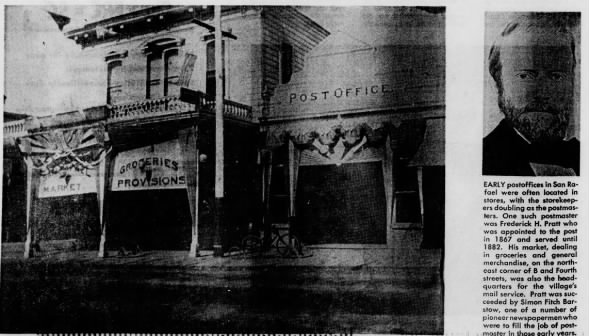

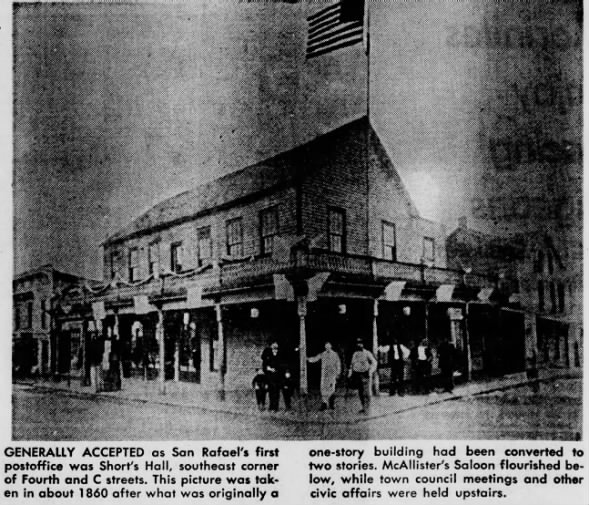




I’ve really enjoyed reading so much history about this fascinating couple and their families! It’s been interesting to learn about my home here in its “sylvan setting in the Oakland Hills.”
ReplyDelete